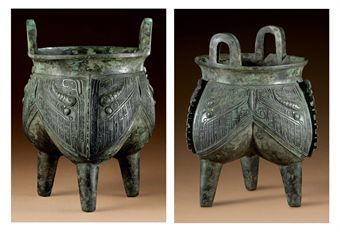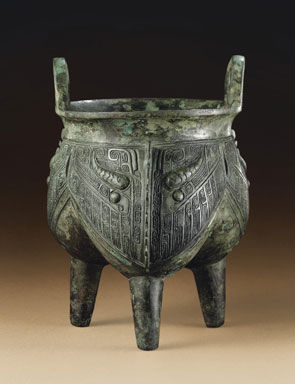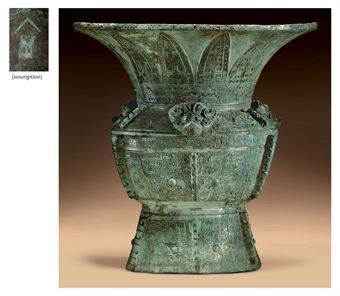Christie's to Offer One of the Most Important Collections of Archaic Bronzes


Photo: Christie´s Images Ltd 2010.
NEW YORK (AP).- Christie’s announced that it has been entrusted with the sale of The Sze Yuan Tang Archaic Bronzes from the Anthony Hardy Collection on September 16 as part of Christie’s Fall Asian Art Week. This collection of approximately 120 lots valued in excess of $15 million will be led by a very rare and important archaic bronze ritual tripod food vessel, Li, from the late Shang dynasty, 12th century BC.
Theow H. Tow, Honorary Chairman of Asia and Deputy Chairman of Americas, said: “Anthony Hardy has studied and amassed an unrivalled personal collection of important Chinese archaic bronze vessels. His connoisseurship over the past 40 years has been informed by his interest in the precision of casting, patination, pictogram inscription and of course provenance of each item. We are honored to provide a unique opportunity for established and new collectors to acquire not only icons of China’s Bronze Age but also to own part of a highly respected, well-published and exhibited collection that has the imprimatur of a knowledgeable collector of impeccable taste who formed his collection with patience and deliberation.”
The Anthony Hardy Collection
The inspiration for Anthony Hardy's Sze Yuan Tang Collection of ancient Chinese bronzes originated in his childhood in England in the early 1950s when he was struck by the architectonic beauty of a jue, a ritual tripod wine decanter, from the Shang dynasty (ca. 16th-11th century BC), in his father's collection of predominantly Western medieval art. This early encounter sparked what was to become a profound life-long fascination with early Chinese art, and in particular, the exquisitely cast ritual bronzes of ancient China.
The Sze Yuan Tang Archaic Bronzes
Many of the magnificent bronze vessels from the Sze Yuan Tang Collection date to the 13th–12th centuries B.C., the Golden Age of the Shang dynasty. This was the period when Anyang, in Northern Henan province, served as the capital, and when some of the finest and most sophisticated bronzes were created. The bronzes were employed by the Shang ruling class for ritual offerings of food and wine to invoke the aid of ancestral spirits. One of the most famous bronzes in the collection is the striking li, a ritual tripod vessel for cooking grains or meat, from the late Shang dynasty, 12th century BC. Formerly in the renowned collections of Dr. A.F. Philips and the British Rail Pension Fund, it was previously exhibited in 1939 by the famed Chinese art dealer, C.T. Loo. This important vessel is cast with three startling taotie animal masks, each formed by a pair of confronted zoomorphic creatures and which, in full face, feature an animal mask with formidable horns and sharply angled eyes reserved on a richly patterned ground of quills and leiwen.
A very rare bronze ritual tripod food vessel, Li, Shang dynasty, 12th century BC. Photo: Christie´s Images Ltd 2010.
The body divided into three deep lobes set above hollow tapering legs, and flat-cast with unusual buffalo masks incorporating bands of vertically arranged quills below elongated eyes and pronounced horns cast in relief, each mask centered by a hooked flange, all within double bow-string borders, with a pair of bail handles rising from the rim, with mottled grey and milky-green patina; 8¼ in. (21 cm.) high, box - Estimate on request
Provenance: C.T. Loo & Co., New York.
Dr. A.F. Phillips Collection; Sotheby's, London, 30 March 1978, lot 11.
British Rail Pension Fund Collection; Sotheby's, London, 12 December 1989, lot 2.
Eskenazi Ltd., London, 26 January 1990.
Literature: Sirén, Kinas Konst Under Tre Artusenden, 1942, vol. I, pl. 3.
Chen Wangheng, Chinese Bronzes: Ferocious Beauty, 2001, pl. iii, no. 17a.
Exhibited: An Exhibition of Chinese Bronzes, C.T. Loo & Co., New York, 1939, pl. IV, no. 8.
On loan: Dallas Museum of Art, 1985-1988.
The Glorious Traditions of Chinese Bronzes, Singapore, 2000, no 6.
Metal, Wood, Water, Fire and Earth, Hong Kong Museum of Art, 2002-2006.
Notes: The combination of shape and decorative features of this rare vessel appear to be unique amongst published examples of li. The diagonally positioned eyes, with the hook-shaped canthus and exaggerated extended outer corner, and the horns cast in relief are particularly distinctive.
A li of Shang date, from Shaanxi Hua Xian, illustrated by R. Bagley, Shang Ritual Bronzes in the Arthur M. Sackler Collections, p. 479, fig. 89.2, shares legs similar to those of the present vessel, as well as similar horns cast in relief, which are part of what are more definitively bold taotie masks. On this vessel the hooked flanges are also bolder and larger. Similar horns cast in relief can also be seen on a li excavated in 1987 in Henan, Anyang province, and now in the Chinese Academy of Social Sciences, Beijing. See, Zhongguo Qingtongqi Quanji - 2 - Shang (2), Beijing, 1997, pp. 68-9, figs. 67-8. A related li, without the dramatic diagonally arranged horns cast in relief, is illustrated in Mostra d'Arte Cinese, Venice, 1954, no. 29. On another related li, illustrated by Chen Peifen, Ancient Chinese Bronzes in the Shanghai Museum, London, 1995, no. 24, the masks are formed by confronted dragons that are very similar in shape to the eyes of the present vessel, but the quills are placed above the dragons, not below.
Another significant lot from the Collection is an important archaic bronze ritual wine vessel and cover, fangyi, from the late Shang dynasty, Anyang period, 12th-11th century BC. Prominent hooked flanges effectively articulate and focus attention on the motifs displayed within the compartments on the striking wine container. Taotie appear on both the cover and body, their individual features —eyes, brows, nose, jaws and horns—standing out in relief on a sea of leiwen. The crisply cast pupils filling the eyes of the taotie on this bronze suggest a semi-human being; the hint belied, however, by the fantastic horns and the pointed ears. The inscription on both vessel and cover provides the clan names of those who made the vessel as well as ancestors to which the vessel was dedicated. This remarkable and important bronze was first published by the late Qing dynasty scholar Wu Dacheng (1835–1902) and has been published and exhibited extensively ever since.
An important and rare bronze wine vessel and cover, Fangyi, late Shang dynasty, Anyang, 12th-11th century BC. Photo: Christie´s Images Ltd 2010.
The tapering body of rectangular section cast in low relief on each side with a taotie mask composed of detached elements cast with leiwen divided by a notched flange, repeated at the corners and in the center of a band of kui dragons below the rim, and addorsed kui dragons on either side of the small arched openings in the foot, all on leiwen grounds, each facet of the roof-shaped cover with an inverted taotie below the knop finial, both the base of the interior and interior of the cover cast with an eight-character inscription within a ya-shaped outline, with heavy malachite encrustation on the interior of the vessel and malachite encrustation on the exterior and interior of the cover; 11¼ in. (28.5 cm.) high, box - Estimate on request
Provenance: Burchard Collection, London. Literature: Wu Dacheng, Kezhai ji gu lu, 1918, vol. 1, no. 4. Exhibited: On loan: Museum Rietberg, Zurich. Notes: The inscriptions cast inside the vessel and cover, each of which consists of eight characters written inside a yaxing, may be interpreted, "Ya Ruo", "Ya Shi", "Ya Shou" and "Ya Xuan", which, according to Li Xueqin, The Glorious Traditions of Chinese Bronzes, p. 72, are clan names of the Yin-Shang period, while "Gui" and the other names are the ancestors to whom sacrifices were offered. The same inscription can be found on a few other bronzes including a very similar fangyi, possibly the pair to the present vessel, formerly in the Avery Brundage Collection, and a yu in the Museum of Fine Arts, Boston, both published by Chen Mengjia, Yin Zhou qingtongqi fenlei tulu, 1977, A641, R137 and A143, R453, respectively.
Ernst Gross-Spühler Collection.
Sotheby's, London, 10 December 1985, lot 8.
Eskenazi Ltd., London, 10 December 1985.
Karlgren, "New Studies on Chinese Bronzes", BMFEA 9, 1937, pl. XXVII, no. 1268; and pp. 17, 68, and 81.
Barnard and Cheung, Rubbings and Hand Copies of Bronze Inscriptions in Chinese, Japanese, European, American and Australasian Collections, 1978, vol. 8, fig. 1026.
Sun Zhichu, Jinwen zhulu jian mu, 1981, no. 4525.
Hayashi, In Shu jidai seidoki soran ichi, 1984, vol. 1, pl. 252, no. 29.
Wang Tao and Liu Yu, A Selection of Early Chinese Bronzes, 2007, p. 324.
Yin Zhou Jin wen ji cheng, 2007, vol. 6, nos. 9886 and 9887.
Bronzen aus dem alten China, Museum Rietberg, 1975, cat. no. 24.
Ancient Chinese and Ordos Bronzes, Hong Kong Museum of Art, 1990, no. 16.
The Glorious Traditions of Chinese Bronzes, Singapore, 2000, no. 18.
Metal, Wood, Water, Fire and Earth, Hong Kong Museum of Art, 2002-2006, p. 109.
Fangyi appear to have been one of the most prized of ritual vessels, as they have been found in fewer and more sumptuous tombs then jue and gu. In Ancient Chinese and Ordos Bronzes, p. 92, J. Rawson and E. Bunker, in their discussion of this vessel, note that during the Shang dynasty rare vessels of this type were used in pairs, as seen in the tomb of Fu Hao, Yinxu Fu Hao mu, Beijing, 1980, pls. XVIII (2) and XIX (1 and 2). They are thought to have been used to store wine, and the heavy malachite encrustation in the base of the interior of the present vessel is most likely the remains of some kind of wine made from grain. A distinctive feature of this vessel is the use of leiwen or intaglio decoration on the motifs, which can also be seen on a very similar fangyi included in the Exhibition of Chinese Arts, C.T. Loo & Co., New York, 1 November 1941 - 30 April 1942, no. 32. This feature can also be seen on a related fangyi, illustrated by B. Karlgren, "Bronzes in the Wessén Collection", BMFEA 30, 1958, pls. 1-3.
A fangyi with very similar bands of decoration, but lacking the leiwen ground design and the intaglio decoration on the raised motifs, is in the Palace Museum, Beijing. See, The Complete Collection of Treasures of the Palace Museum - 27 - Bronze Ritual Vessels and Musical Instruments, Hong Kong, 2006, p. 142, no. 91. (Fig. 1)
Another magnificent bronze is the rare and impressively large ritual wine vessel known as a zun, from the late Shang dynasty, Anyang period, circa 13th century BC (estimate: $400,000-600,000) that also prominently features taotie, which adorn the wide bands encircling the tall splayed foot and the broad mid-section. The canted shoulder is cast in high relief with three bovine masks sporting curled, ram-like horns, while upright blades cast with patterns encircle the expansive trumpet mouth. Sealed bronze vessels from the Shang and Western Zhou dynasties (circa 1100–771 BC) have yielded specialized rice and millet wines flavored with herbs, flowers and possibly tree resins, reminding one that the Chinese have enjoyed drinking wine for more than 9,000 years, longer than any other civilization.
A rare finely cast large bronze ritual wine vessel, Zun, Shang dynasty, Anyang period, circa 13th century BC. Photo: Christie´s Images Ltd 2010.
The body and tall flared foot flat-cast with three large taotie masks divided and separated by hooked flanges, the taotie positioned below rams' heads cast in high relief on the shoulder between pairs of kui dragons, all below a dragon band and upright scroll-filled blades on the trumpet-shaped neck, with a single character cast in the base of the interior, with mottled milky-green patina and malachite and azurite encrustation; 11¾ in. (30 cm.) high, 11¾ in. (30 cm.) across, box - Estimate $400,000-600,000
Provenance : Kyuzaburo Wada Collection, Kobe, Japan.
Kochukyo Co. Ltd., Tokyo, 26 September 1984.
Literature: Umehara, Nihon shucho Shina kodo seikwa, 1959, vol. II, pl. CXXVI.
Exhibited: Ancient Chinese and Ordos Bronzes, Hong Kong Museum of Art, 1990, no. 12. Lot Notes: The inscription in the bottom of the zun consists of an undeciphered graph. The same graph can be found on other vessels, two of which are illustrated by R. Bagley, Shang Ritual Bronzes in the Arthur M. Sackler Collections, pp. 496-7, no. 96, a yu, and fig. 96.1, a zhi in the Ashmolean Museum, Oxford. A pan with the same graph, in the Mayer Collection, is illustrated by M. Loehr, Ritual Vessels of Bronze Age China, The Asia Society, New York, 1968, no. 28.
The Glorious Traditions of Chinese Bronzes, Singapore, 2000, no. 17.
Metal, Wood, Water, Fire and Earth, Hong Kong Museum of Art, 2002-2006, no. 87 and p. 109.
This zun with its imposing form and intricate decoration is representative of the type made during the mid-Anyang period. A similar pair found in Fu Hao's tomb, is illustrated in Yinxu Fu Hao mu, Beijing, 1980, pl. XXII (1 and 2). Others in public collections have also been published: one in the British Museum, illustrated by W. Watson, Ancient Chinese Bronzes, pl. 9a; another in the Pillsbury Collection, illustrated by B. Karlgren, A Catalogue of the Chinese Bronzes in the Alfred R. Pillsbury Collection, Minneapolis, 1952, pl. 41, no. 28; and one in the Avery Brundage Collection, illustrated by B. Karlgren, "Marginalia on Some Bronze Albums II", BMFEA 32, 1960, pp. 1-25, pl. 22a, has very similar registers of decoration, but no notched flanges separating the taotie masks on the body and foot. Another similar example of somewhat larger size (14 in. high) is illustrated by d'Argencé, Ancient Chinese Bronzes in the Avery Brundage Collection, de Young Museum Society, 1966, pl. XI.
Auctions: The Sze Yuan Tang Archaic Bronzes from the Anthony Hardy Collection September 16
Viewing: Christie's Rockefeller Center Galleries September 10-15

/https%3A%2F%2Fprofilepics.canalblog.com%2Fprofilepics%2F1%2F0%2F100183.jpg)





/http%3A%2F%2Fstorage.canalblog.com%2F92%2F50%2F119589%2F64856588_p.jpg)
/http%3A%2F%2Fstorage.canalblog.com%2F47%2F64%2F577050%2F64610226_o.jpg)
/http%3A%2F%2Fstorage.canalblog.com%2F56%2F66%2F577050%2F57442462_o.jpg)
/http%3A%2F%2Fstorage.canalblog.com%2F98%2F29%2F577050%2F57152223_o.jpg)